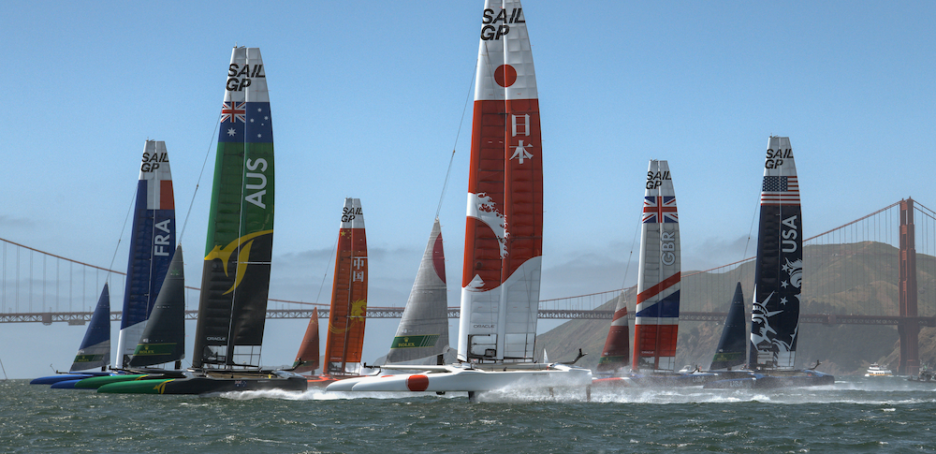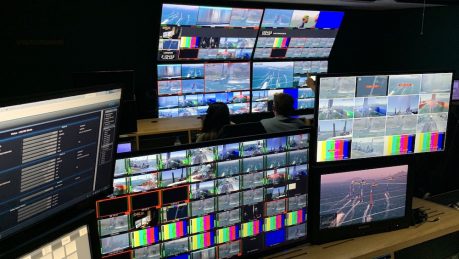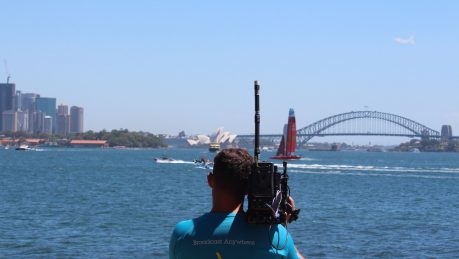

SailGP is an annual, global sports league featuring bold, cutting-edge technology and awe-inspiring athleticism.
Since the world premiere in Sydney on February 15 2019, SailGP has delivered an innovative and environmentally considerate solution to provide high-quality and consistent TV coverage of the new, annual global sailing championship.
SailGP works with partners Whisper, Timeline TV, Oracle and Tata to deliver this ambitious project which pushes the boundaries with a remote production solution that delivers its programming into over 100 broadcast territories as well as a complementary, state-of-the-art app making SailGP available to a wide range of people.
The project enables live world feeds to be fully produced in London. The television director, sat more than 10,000 miles away from where the action is happening, has access to over 40 video and data sources including; the award winning, patented LiveLine FX technology for impactful on screen graphics and data derived from a total of 1,200 sensors placed on the boats and athletes; 12 boat mounted, remote-controlled, agile cameras, 4 water based cameras mounted onto a helicopter, a drone and 2 chase boats and 4 RF cameras based on the shore.
Key innovations in this landmark remote production include the integration of super low latency technologies and the in-house design of bespoke equipment such as IP controlled waterproof cameras that self-clean at sea.
Design
SailGP sees one design, high performance catamarans compete, while reaching speeds of 50+ knots, and represents the most technologically advanced class of sail race boat in the world. However, this presents a number of technical challenges for the broadcast team with cameras operating in harsh environments. SailGP’s technology team and Timeline worked closely to design and install onboard cameras, that had to overcome constraints around cabling, battery power, space, weight and cooling.
The result is the creation of dynamic waterproof camera systems boasting 360-degree pan, tilt and zoom, and full functionality control from shore. These cameras provide extremely high-quality images, are extremely rugged and include a number of practical innovations to aid their use during racing. As the units and lenses get covered in salt water, each camera has a built-in lens wipe function and uses a store of fresh water to clean the lens and overcome the challenge of being inaccessible to technicians during the race. As all race coverage is provided from RF camera sources it is essential that these on-board cameras can be relied upon to provide great pictures throughout the event.
Timeline designed the on-board waterproof cameras using H265 video encoding to deliver 4 camera angles from every boat to the shore. Using SMPTE 2022 IP standards the transport stream from the boat was delivered to Timeline’s Ealing Broadcast Centre. This enabled a low latency, identical signal to be decoded in Ealing to enable the remote production to be produced.
Connectivity
SailGP is a complex RF project and the signals from the racing boats cameras are transmitted from the masthead of the 24 metre high wingsails and received on land by an array of specially designed antenna. A suitable spectrum was agreed with the local regulator to ensure an interference free link. The resilience of RF coverage is crucial to the overall success of the project, as all race coverage is RF linked. Timeline’s experienced team draw on their decades of experience to ensure this. Connectivity at the inaugural event was supported by the installation of a 1km underwater fibre optic cable to connect the Sydney Harbour mainland to the Shark Island, where the programme presentation and the RF link receivers were located.
Meanwhile, the Ealing Broadcast Centre sends and receives over 50 video circuits, multiple audio circuits, 4-wire VOIP circuits and a complete control network to enable tallies and GPI’s to pass to the OB.
Sources from the Outside Broadcast are sent back to the Ealing Broadcast Centre utilising the Tata Video Connect Fibre Network. Resilience is a key consideration of this project and to mitigate against single points of failure, Tata provide dual fibre routes from the OB to London, routed different ways around their globe.
To enable Whisper to produce a full host production from London, SailGP had to overcome a number of key challenges including signal latency. Keeping to single code/decode cycle all the way from each boat to London was critical in keeping the delay low. In order to achieve the desired picture quality in the available bandwidth, Sail GP used H-265 compression on the DTC links, which were received on shore and then sent as ASI – SMPTE 2022 using an Appear X20 solution. In Ealing the Appear platform delivered full redundant hitless ASI into the DTC decoders. This ensured no re-coding and very low latency.
Success & Benefits
Sustainability is embedded within SailGP’s and at the heart of the global championship. This project helped that mission by drastically reducing the amount of staff and equipment sent to the event location. When compared to the traditional OB model, remote production saves hundreds of thousands of crew air-miles, as over 60 staff work from the Ealing Broadcast Centre.
This produced a saving of hundreds of tonnes of CO2 emissions, with the true benefit being much higher when the efficiencies of not shipping equipment are considered. Reducing the need for staff to make lengthy journeys impacts positively on the health, comfort and wellbeing of the crew.
SailGP Director of Technology, Warren Jones: “We are delighted that we have not only launched a new sport, but we used the latest remote production trends to do it. At the start of this project, we looked at all the deliverables with our partners, and determined that this was the best solution to satisfy our broadcast partners, deliver a complementary, state-of-the-art app and make SailGP available to a wide range of people.”
Whisper CEO, Sunil Patel: “As always, at Whisper we were very ambitious with our SailGP production plans, which included some innovative ‘firsts’ in international sports broadcasting – such as delivering a complete, fully produced programme into China with end-product graphics and commentary. Our remote cost-effective production approach enabled us to deliver an extensive portfolio of high-level international products within budget, yet we were careful to invest money in the right places to ensure viewers still felt immersed in the thrilling on-water action.”
Timeline Television CEO, Daniel McDonnell: “Crew working in the London galleries almost forgot they were across the world in a different location. There was low delay talkback to crew on the ground over in Sydney making the whole production feel smooth, seamless and closely connected”.




